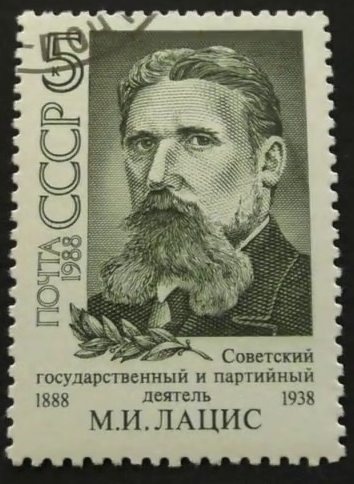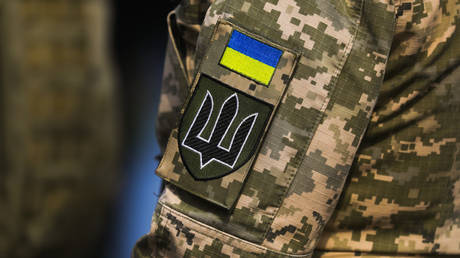The Red Terror in Kiev: A Warning from a Century Ago, Part 1
1,851 words
Part 1 of 2
Sometimes a timely warning comes from an unlikely place. A footnote in Francis Parker Yockey’s Imperium led to a shocking find in what was, even in his day, a dusty tome on some university library shelves. The emended citation is Current History, Vol. XI, Part 1, No. 3, published in December 1919. The item cited turns out to be an uncredited article, “The Red Terror in Kiev,” that appears on page 488. Lest one suspect the journal of partiality, Comrade Trotsky has his say two articles later in “How We Made the October Revolution.”
Current History, a monthly compendium by the New York Times, can be a good resource for getting in-depth takes on events as they were taking place. There’s something unique about such perspectives. The authors didn’t know what the ultimate repercussions of the events they were writing about would be years after the dust had settled, but they were contemplating the possibilities. Although it’s inevitable that not every angle is represented, this journal’s digitized archives still serve as a valuable resource for online historical research, as well as an attractive alternative to more conventional sources. For example, at present Wikipedia’s article on the history of Kyiv sees fit to mention a census conducted soon after the 1919 Bolshevik occupation began, but nary a word about politically-motivated violence severe enough to render those census statistics a bit obsolete.
Mass murder in Kiev

The monument in Kiev to Cheka thugs, which was erected in 1967 and demolished in 2016. In its day it was surely a much-beloved picnic spot for the locals. (Image courtesy of Flickr)
Toward the end of January of 1919, Kiev — or Kyiv, in Ukrainian transliteration — came under attack by Red (Bolshevik) forces. The White (counterrevolutionary) army retook the city at the end of August. Before long, grim news accounts emerged of what had occurred during the approximately 200 days under occupation:
When a London Times correspondent reached the city by airplane from Warsaw on Sept. 17 he found it a place of horrors.
“I do not know,” he wrote, “of any other town in which the Bolsheviki have left such ghastly traces of their fiendish work as they have here. No one knows how many persons perished, but reckoning by the number of bodies which have been found (buried or unburied), there must have been at least 2,000 victims. The anatomical theatre of the university was used as a mortuary for the executed dead, and the volunteer army when they entered the city found about 200 corpses lying there in a state of horrible putrefaction. In a room in a private house 140 more were found, locked up and left to rot.”

You can buy Greg Johnson’s Against Imperialism here.
Four long paragraphs follow, grimly describing a pair of houses commandeered by anti-counterrevolutionary committees: one for Kiev, the other for the rest of Ukraine. These served as torture chambers and slaughterhouses that were littered with corpses and filled with an overpowering stench of decaying flesh:
The strangest part of the Kiev episode is the fact that a handful of soldiers — perhaps 5,000 in all — and about 200 men, none of them educated, and almost all newcomers to the city, the majority of them dissipated and diseased, were able to hold for seven months a population of 200,000 in slavish subjection.
Now hold that thought. How did they pull this off? Note this well:
One reason was that on entering the city the Bolsheviki searched every drawer, cupboard, and cranny for firearms; another was that the people were constantly in a state of semi-starvation. A Kiev journalist, Jean Kalinnikov, who has long studied Bolshevist methods, adds the further explanation that the Moscow Government has worked out a deliberate system of rendering a population supine by terror.
Perhaps that’s something to think about the next time some Leftist politician wants to take away your guns for your own protection.
The ringleader
A Cheka agent headed the operation who was highly ideologically committed and personally involved in the dirty work. Compared to the 200 rank-and-file Bolsheviks, it’s probable that he was the most clear-headed, at least as far as meatpacking specialists are concerned:
A special correspondent of The London Morning Post, who visited Kiev, wrote on Sept. 19:
In Kiev the man who performed this all-vital work for Lenin and Trotzky was a brother-in-law of the notorious Peters of Petrograd. His name was Latsis, and he is a Lett by birth. Soon after the Bolshevist occupation in January he was sent on from Moscow to become chief of the Commission for the Suppression of Counter-revolution in Kiev — the Kiev Chiesvechayna. Concerning the man’s earlier antecedents I was not able to get any exact information, except that he was a Jew and had been identified with the Bolshevist movement from the beginning.
Much more follows about the group’s nightly raids, in which they dragged citizens out of bed, hauled them to the commandeered house, and interrogated them. Often this ended in a summary execution.
Solzhenitsyn’s The Gulag Archipelago mentions some of Latsis’ other activities. This Cheka agent from Latvia shared his thoughts on jurisprudence in a 1918 magazine article:
We are not fighting against single individuals. We are exterminating the bourgeoisie as a class. Do not look in materials you have gathered for evidence that a suspect acted or spoke against the Soviet authorities. The first question you should ask him is what class he belongs to, what is his origin, education, profession. These questions should determine his fate. This is the essence of the Red Terror.
Two decades later, he got thrown under the bus with extreme prejudice, presumably after having outlived his usefulness during the normalization phase. Even so, later on he got his mug on a five-kopeck Soviet postage stamp, a distinction he shares with the treasonous double agent Kim Philby. Surely it was a big hit with Ukrainian philatelists, back in the day.
Rosa Schwartz’s crime
The article then describes the fate of the celebrated professor “Dr. [Timofey] Florinsky, one of the greatest of all authorities on Slavic history and law”:
At the time of the coming of the Bolsheviki, Dr. Florinsky, like a great number of the other professors in the university, did not flee, because it was reported then, and generally believed, that Lenin and Trotzky had abandoned their policy of attempting to exterminate the intellectuals, and were, on the contrary, trying to coax them into the movement. He stayed on.
Things didn’t turn out as expected, to say the least. Kiev’s leading intellectuals were indeed being targeted, other than surgeons, who were spared because of their valuable skills. Professor Florinsky was rounded up and brought in for interrogation one night, arriving at around 2 AM. Then:
The usual gathering was there, including, as usual, Rosa Schwartz, a Kiev prostitute, who was used as an agent by Latsis, and was in effect an unofficial member of the Chresvechayna.
Upon seeing the dignified, gray-haired professor, she took a personal interest:
Schwartz, a dark, impudent type of woman, bedecked with diamonds, for she always wore much jewelry, demanded the privilege of examining the professor. Latsis agreed. At length she put a certain question; I did not learn what the question was, but at it Florinsky stiffened and drew erect. The situation is readily conceived; the embodiment of all that is noble in the world on the grill before all that is ignoble in the world, the prostitute harrying the saint. The historian’s reply was slow in coming. At Schwartz’s elbow lay a small revolver which she invariably kept by her. In a sudden spasm of emotion she fired, and Florinsky was dead, and within a few moments his body had been cast into the dark garden behind. Mme. Florinsky subsequently recovered the body by making a payment of 25,000 rubles.
Other sources state that she was drunk and acting as a judge. (Obviously this judicial role was merely in a nominal sense, give that these proceedings didn’t even rise to the standard of a kangaroo court, which at least pretends to be a trial.) Rosa Schwartz received no penalty for summarily executing the city’s most eminent professor in a fit of spiteful pique. In any event, if your concept of pinkettes was informed by cute and remarkably friendly KGB babes in the concluding scenes of certain James Bond movies, this soiled rose was quite different.
Don’t look for this story on Wikipedia, by the way, as it got memory-holed by an anonymous “editor.” But considerable further details exist about this snowflake, including her bizarre dinner parties likewise starring “Comrade Vera” (perhaps Vera Grebennikova). Given Schwartz’s remarkably sadistic habits, the professor was relatively fortunate to experience a quick death.
Methods of torture

You can buy Beau Albrecht’s Space Vixen Trek here.
If your idea of a sadist is someone attending a bondage-and-sadomasochism party with a leather flogger, that hardly scratches the surface. The Cheka in Kiev mainly used three torture techniques. The first was beatings. The second involved delivering an execution decree, which was sometimes a bluff but in other cases was sometimes carried out. The third was described as “confinement.” This involved locking a number of prisoners in a small room and then executing one or more of them while making the others watch. The London Morning Post correspondent described the condition of the rooms that the surviving prisoner had had to share with the cadavers for one to four days:
These were windowless holes with spattered walls, and floors still glistening, despite heavy overlays of chloride of lime, with blood, and none too sure to the foot by reason of human particles as yet unremoved. The mind recoils from the thought of what those rooms must have been on a hot Russian night, when powder smoke still clung heavily in the air, and the very rafters still echoed with dying screams.
Being placed in a coffin beside the cadaver of a recently-executed prisoner was another method of “confinement.” Either way, survivors were often driven insane by the experience.
Executions
Prisoners were sometimes bludgeoned on the head, but more often shot. Cadavers were frequently left in Kiev University’s operating rooms for its medical department, which left the place an abattoir. The correspondent concludes:
The entire story seems horribly unreal. One has a sense that none of the chapter I have recorded could possibly have happened in our day. But it did happen. Professor Lipinsky has declared to me that it happened. Dr. Dietrichs, the Professor of Surgery in Kiev University, has affirmed it; so, too, has Professor Kraynsky, the psychologist, and the very cool-eyed Countess Medivedieff of the Russian Red Cross. There were others, including General Bredov, Denikin’s representative in Kiev. I could go on at much greater length, but it is not necessary. The case is this: A handful of alien commissaries, with only a most slender garrison at their command, held the 200,000 people of Kiev in utter subjugation for seven months. They did it by propagating fear, by scientifically creating, with methods in large degree indicated from Moscow, a Red Terror.
Regarding these commissaries, it turns out that the Russian Revolution wasn’t very Russian after all. More on this in the next part.





